University Hotel Sales & Marketing Module: Sales Techniques Assignment
VerifiedAdded on 2023/04/17
|7
|1039
|455
Homework Assignment
AI Summary
This assignment explores various techniques for hotel sales, focusing on overcoming customer objections and effectively closing sales. The document outlines five techniques for each category, providing a description of each technique, a scenario where it would be applicable, and an example of what a salesperson might say. Techniques to overcome objections include showing gratitude, showing value, SPIN selling, using proofs and customer references, and empathizing with customer concerns. Sales closing techniques covered are the now or never close, the option close, the inoffensive close, the sharp angle close, and the backwards close. Each technique is clearly explained with practical examples, supported by references from academic journals, providing a comprehensive guide to improving sales performance in the hospitality industry.
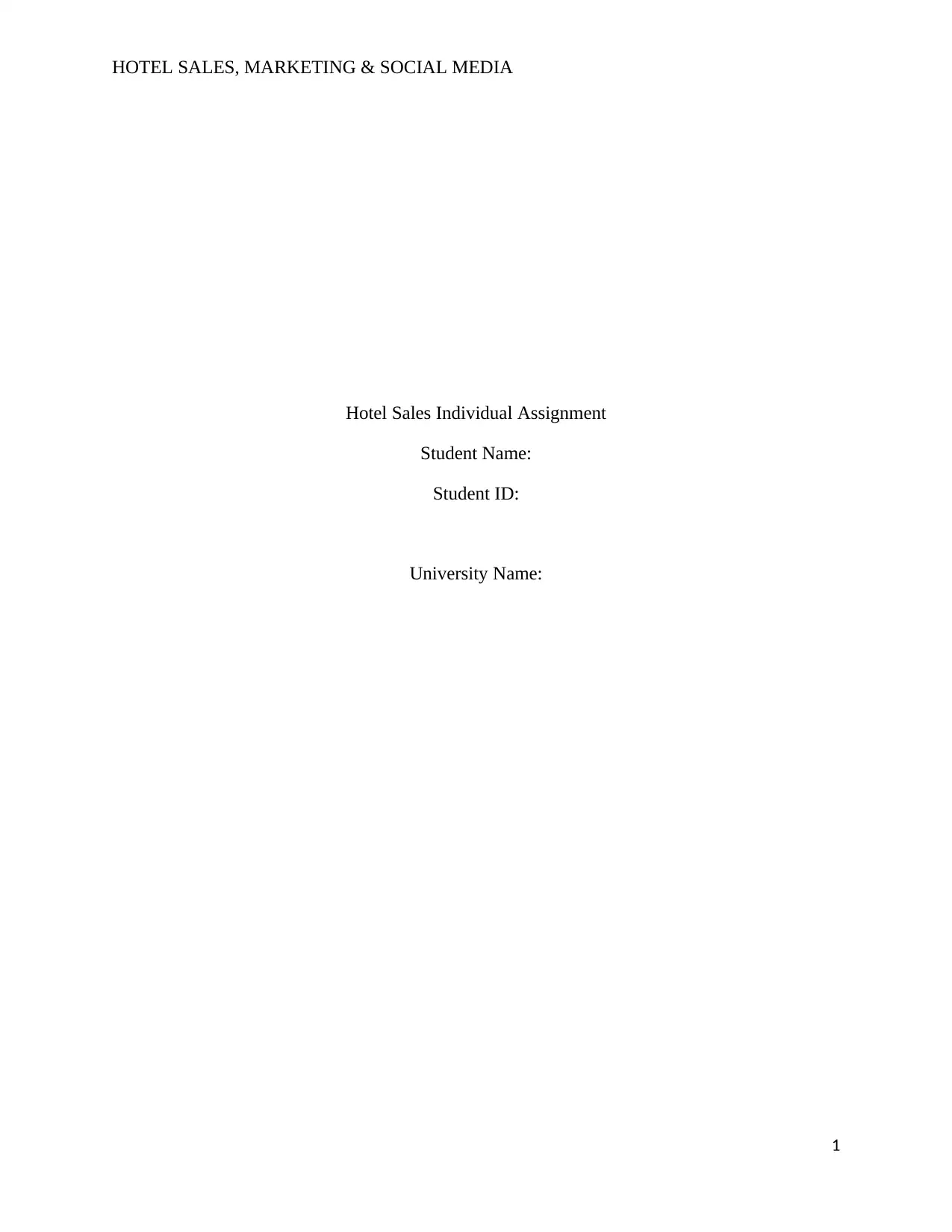
HOTEL SALES, MARKETING & SOCIAL MEDIA
Hotel Sales Individual Assignment
Student Name:
Student ID:
University Name:
1
Hotel Sales Individual Assignment
Student Name:
Student ID:
University Name:
1
Paraphrase This Document
Need a fresh take? Get an instant paraphrase of this document with our AI Paraphraser
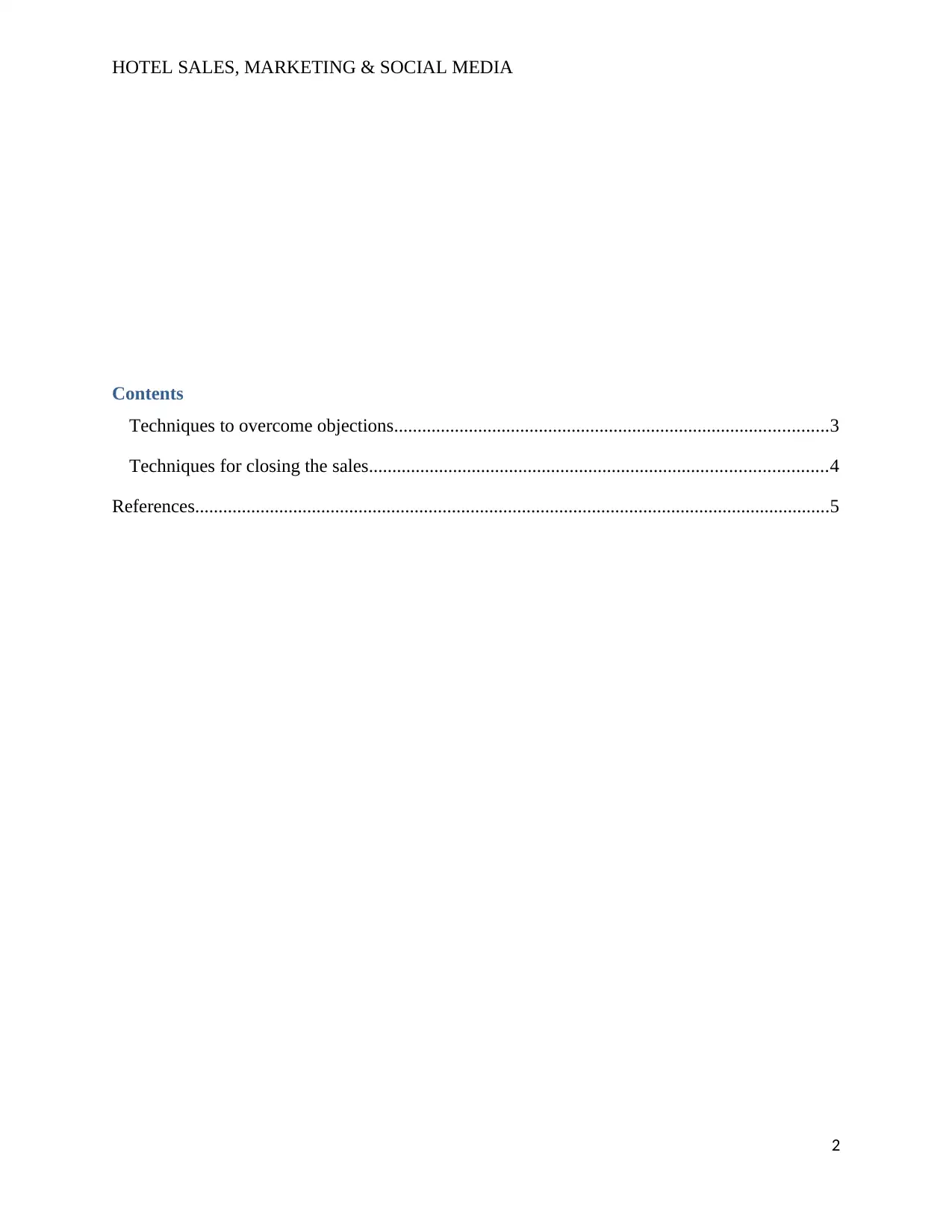
HOTEL SALES, MARKETING & SOCIAL MEDIA
Contents
Techniques to overcome objections.............................................................................................3
Techniques for closing the sales..................................................................................................4
References........................................................................................................................................5
2
Contents
Techniques to overcome objections.............................................................................................3
Techniques for closing the sales..................................................................................................4
References........................................................................................................................................5
2
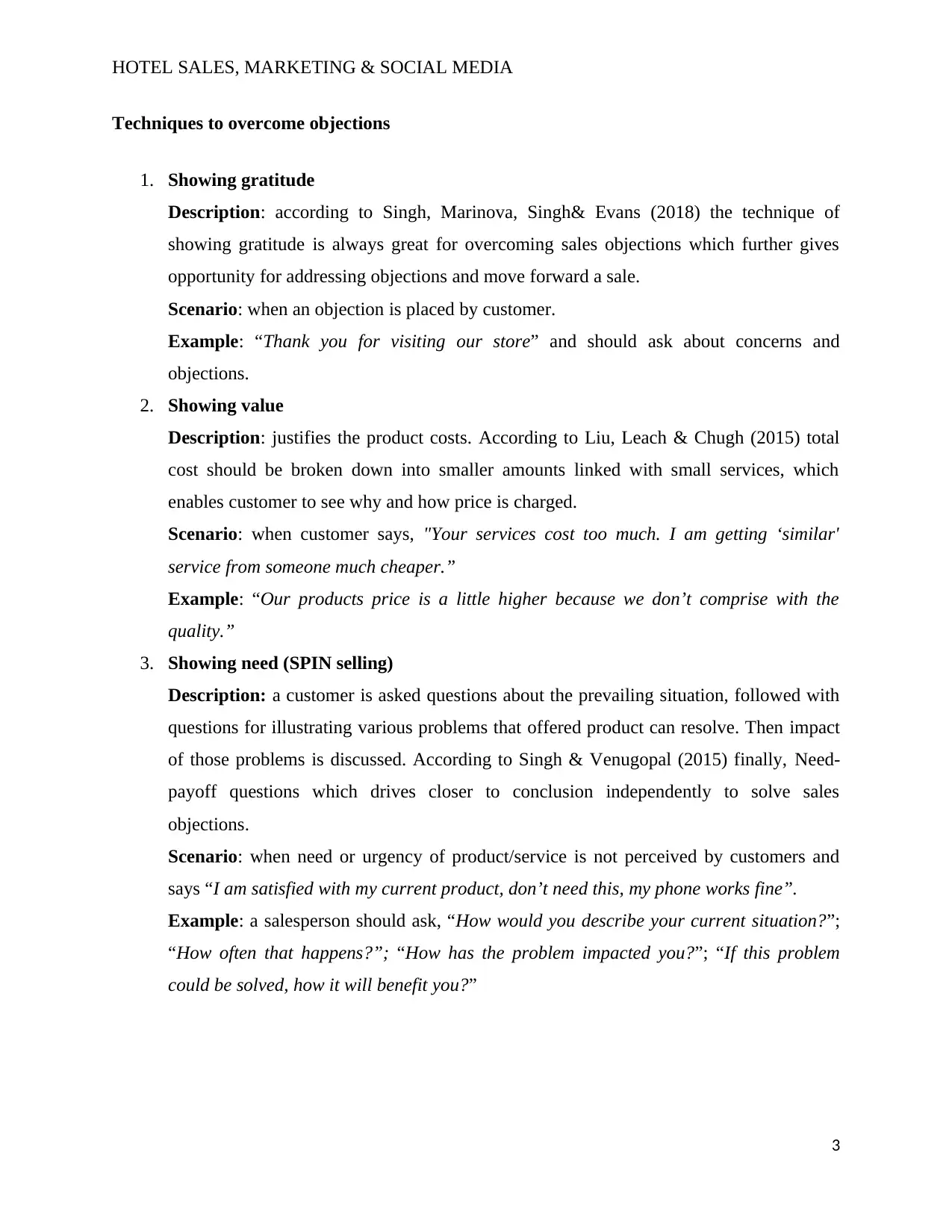
HOTEL SALES, MARKETING & SOCIAL MEDIA
Techniques to overcome objections
1. Showing gratitude
Description: according to Singh, Marinova, Singh& Evans (2018) the technique of
showing gratitude is always great for overcoming sales objections which further gives
opportunity for addressing objections and move forward a sale.
Scenario: when an objection is placed by customer.
Example: “Thank you for visiting our store” and should ask about concerns and
objections.
2. Showing value
Description: justifies the product costs. According to Liu, Leach & Chugh (2015) total
cost should be broken down into smaller amounts linked with small services, which
enables customer to see why and how price is charged.
Scenario: when customer says, "Your services cost too much. I am getting ‘similar'
service from someone much cheaper.”
Example: “Our products price is a little higher because we don’t comprise with the
quality.”
3. Showing need (SPIN selling)
Description: a customer is asked questions about the prevailing situation, followed with
questions for illustrating various problems that offered product can resolve. Then impact
of those problems is discussed. According to Singh & Venugopal (2015) finally, Need-
payoff questions which drives closer to conclusion independently to solve sales
objections.
Scenario: when need or urgency of product/service is not perceived by customers and
says “I am satisfied with my current product, don’t need this, my phone works fine”.
Example: a salesperson should ask, “How would you describe your current situation?”;
“How often that happens?”; “How has the problem impacted you?”; “If this problem
could be solved, how it will benefit you?”
3
Techniques to overcome objections
1. Showing gratitude
Description: according to Singh, Marinova, Singh& Evans (2018) the technique of
showing gratitude is always great for overcoming sales objections which further gives
opportunity for addressing objections and move forward a sale.
Scenario: when an objection is placed by customer.
Example: “Thank you for visiting our store” and should ask about concerns and
objections.
2. Showing value
Description: justifies the product costs. According to Liu, Leach & Chugh (2015) total
cost should be broken down into smaller amounts linked with small services, which
enables customer to see why and how price is charged.
Scenario: when customer says, "Your services cost too much. I am getting ‘similar'
service from someone much cheaper.”
Example: “Our products price is a little higher because we don’t comprise with the
quality.”
3. Showing need (SPIN selling)
Description: a customer is asked questions about the prevailing situation, followed with
questions for illustrating various problems that offered product can resolve. Then impact
of those problems is discussed. According to Singh & Venugopal (2015) finally, Need-
payoff questions which drives closer to conclusion independently to solve sales
objections.
Scenario: when need or urgency of product/service is not perceived by customers and
says “I am satisfied with my current product, don’t need this, my phone works fine”.
Example: a salesperson should ask, “How would you describe your current situation?”;
“How often that happens?”; “How has the problem impacted you?”; “If this problem
could be solved, how it will benefit you?”
3
⊘ This is a preview!⊘
Do you want full access?
Subscribe today to unlock all pages.

Trusted by 1+ million students worldwide
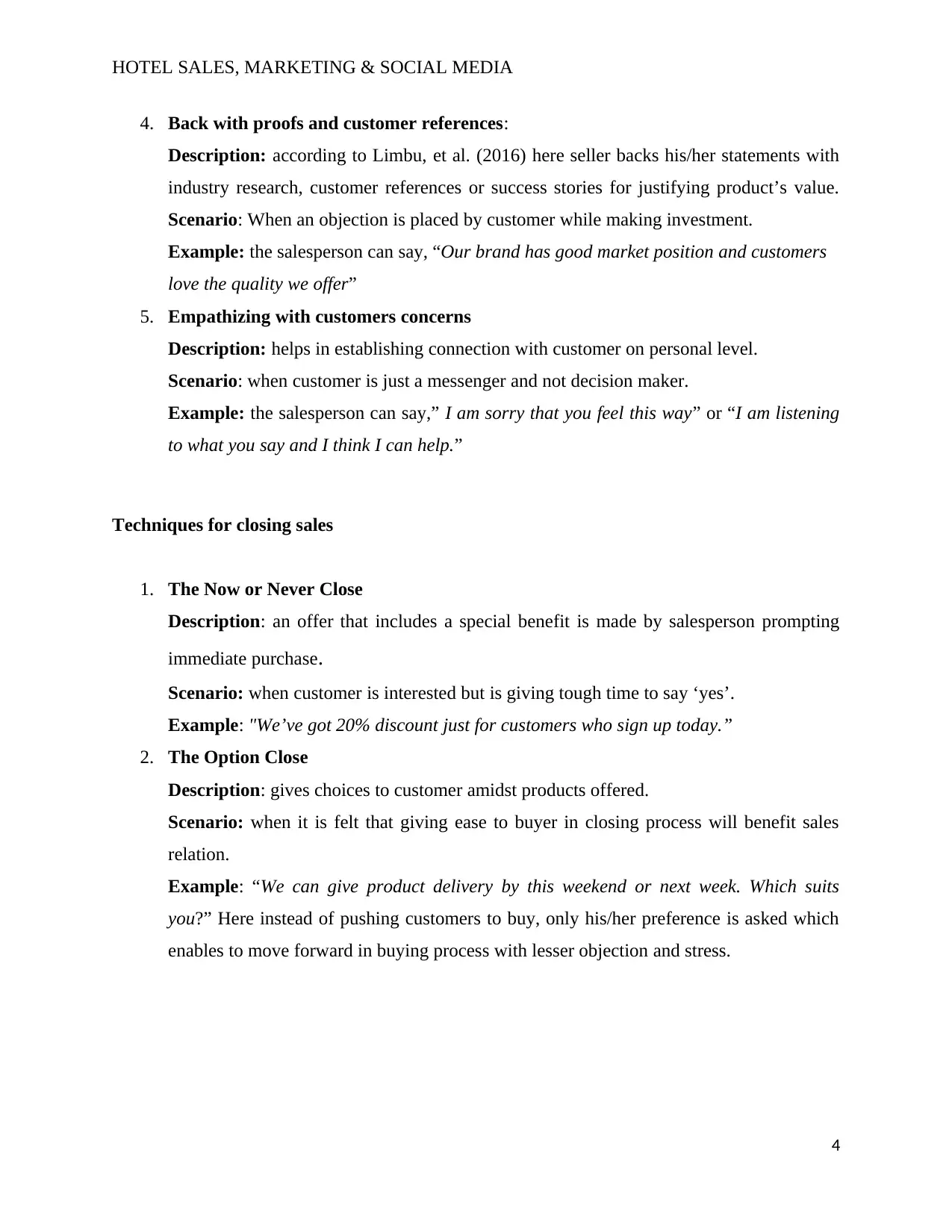
HOTEL SALES, MARKETING & SOCIAL MEDIA
4. Back with proofs and customer references:
Description: according to Limbu, et al. (2016) here seller backs his/her statements with
industry research, customer references or success stories for justifying product’s value.
Scenario: When an objection is placed by customer while making investment.
Example: the salesperson can say, “Our brand has good market position and customers
love the quality we offer”
5. Empathizing with customers concerns
Description: helps in establishing connection with customer on personal level.
Scenario: when customer is just a messenger and not decision maker.
Example: the salesperson can say,” I am sorry that you feel this way” or “I am listening
to what you say and I think I can help.”
Techniques for closing sales
1. The Now or Never Close
Description: an offer that includes a special benefit is made by salesperson prompting
immediate purchase.
Scenario: when customer is interested but is giving tough time to say ‘yes’.
Example: "We’ve got 20% discount just for customers who sign up today.”
2. The Option Close
Description: gives choices to customer amidst products offered.
Scenario: when it is felt that giving ease to buyer in closing process will benefit sales
relation.
Example: “We can give product delivery by this weekend or next week. Which suits
you?” Here instead of pushing customers to buy, only his/her preference is asked which
enables to move forward in buying process with lesser objection and stress.
4
4. Back with proofs and customer references:
Description: according to Limbu, et al. (2016) here seller backs his/her statements with
industry research, customer references or success stories for justifying product’s value.
Scenario: When an objection is placed by customer while making investment.
Example: the salesperson can say, “Our brand has good market position and customers
love the quality we offer”
5. Empathizing with customers concerns
Description: helps in establishing connection with customer on personal level.
Scenario: when customer is just a messenger and not decision maker.
Example: the salesperson can say,” I am sorry that you feel this way” or “I am listening
to what you say and I think I can help.”
Techniques for closing sales
1. The Now or Never Close
Description: an offer that includes a special benefit is made by salesperson prompting
immediate purchase.
Scenario: when customer is interested but is giving tough time to say ‘yes’.
Example: "We’ve got 20% discount just for customers who sign up today.”
2. The Option Close
Description: gives choices to customer amidst products offered.
Scenario: when it is felt that giving ease to buyer in closing process will benefit sales
relation.
Example: “We can give product delivery by this weekend or next week. Which suits
you?” Here instead of pushing customers to buy, only his/her preference is asked which
enables to move forward in buying process with lesser objection and stress.
4
Paraphrase This Document
Need a fresh take? Get an instant paraphrase of this document with our AI Paraphraser
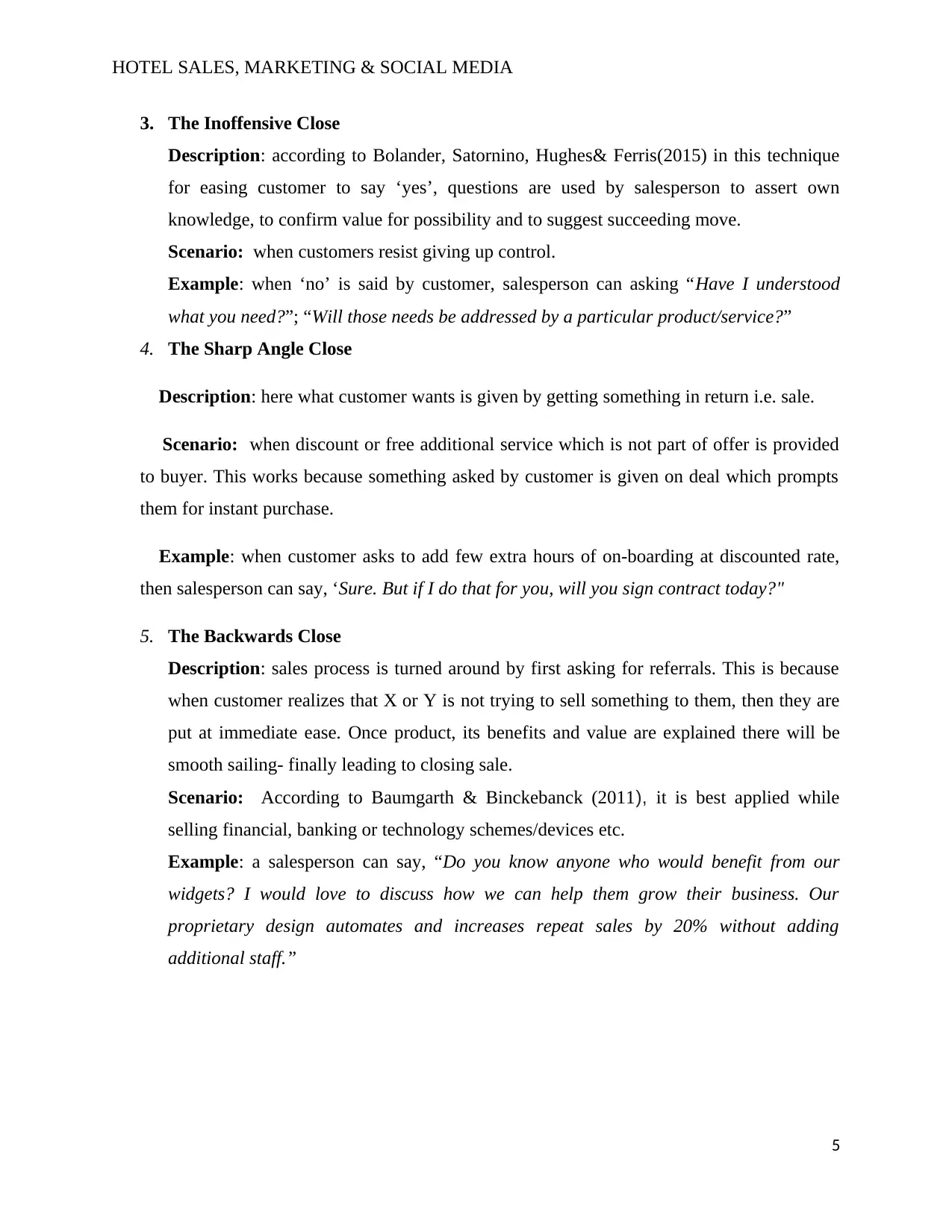
HOTEL SALES, MARKETING & SOCIAL MEDIA
3. The Inoffensive Close
Description: according to Bolander, Satornino, Hughes& Ferris(2015) in this technique
for easing customer to say ‘yes’, questions are used by salesperson to assert own
knowledge, to confirm value for possibility and to suggest succeeding move.
Scenario: when customers resist giving up control.
Example: when ‘no’ is said by customer, salesperson can asking “Have I understood
what you need?”; “Will those needs be addressed by a particular product/service?”
4. The Sharp Angle Close
Description: here what customer wants is given by getting something in return i.e. sale.
Scenario: when discount or free additional service which is not part of offer is provided
to buyer. This works because something asked by customer is given on deal which prompts
them for instant purchase.
Example: when customer asks to add few extra hours of on-boarding at discounted rate,
then salesperson can say, ‘Sure. But if I do that for you, will you sign contract today?"
5. The Backwards Close
Description: sales process is turned around by first asking for referrals. This is because
when customer realizes that X or Y is not trying to sell something to them, then they are
put at immediate ease. Once product, its benefits and value are explained there will be
smooth sailing- finally leading to closing sale.
Scenario: According to Baumgarth & Binckebanck (2011), it is best applied while
selling financial, banking or technology schemes/devices etc.
Example: a salesperson can say, “Do you know anyone who would benefit from our
widgets? I would love to discuss how we can help them grow their business. Our
proprietary design automates and increases repeat sales by 20% without adding
additional staff.”
5
3. The Inoffensive Close
Description: according to Bolander, Satornino, Hughes& Ferris(2015) in this technique
for easing customer to say ‘yes’, questions are used by salesperson to assert own
knowledge, to confirm value for possibility and to suggest succeeding move.
Scenario: when customers resist giving up control.
Example: when ‘no’ is said by customer, salesperson can asking “Have I understood
what you need?”; “Will those needs be addressed by a particular product/service?”
4. The Sharp Angle Close
Description: here what customer wants is given by getting something in return i.e. sale.
Scenario: when discount or free additional service which is not part of offer is provided
to buyer. This works because something asked by customer is given on deal which prompts
them for instant purchase.
Example: when customer asks to add few extra hours of on-boarding at discounted rate,
then salesperson can say, ‘Sure. But if I do that for you, will you sign contract today?"
5. The Backwards Close
Description: sales process is turned around by first asking for referrals. This is because
when customer realizes that X or Y is not trying to sell something to them, then they are
put at immediate ease. Once product, its benefits and value are explained there will be
smooth sailing- finally leading to closing sale.
Scenario: According to Baumgarth & Binckebanck (2011), it is best applied while
selling financial, banking or technology schemes/devices etc.
Example: a salesperson can say, “Do you know anyone who would benefit from our
widgets? I would love to discuss how we can help them grow their business. Our
proprietary design automates and increases repeat sales by 20% without adding
additional staff.”
5
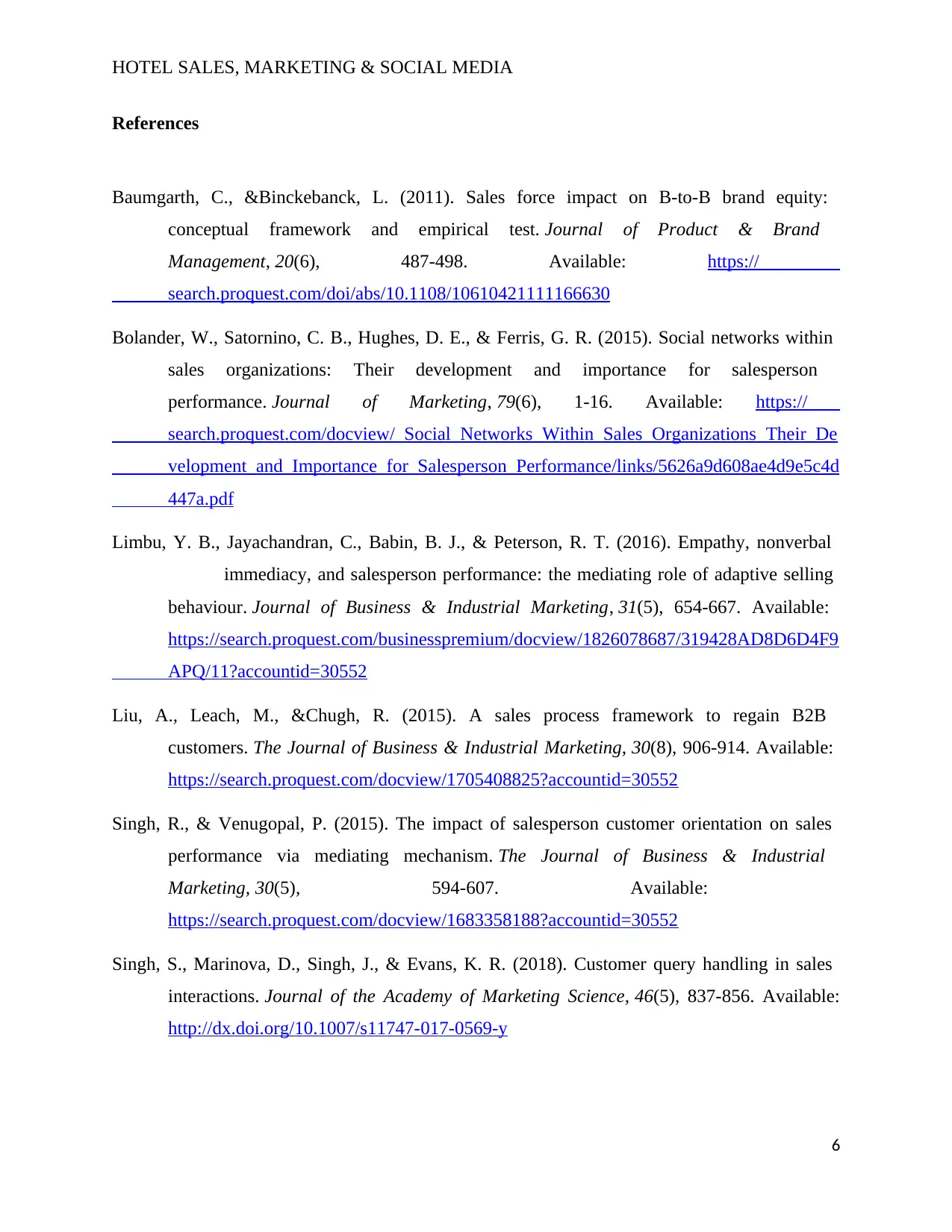
HOTEL SALES, MARKETING & SOCIAL MEDIA
References
Baumgarth, C., &Binckebanck, L. (2011). Sales force impact on B-to-B brand equity:
conceptual framework and empirical test. Journal of Product & Brand
Management, 20(6), 487-498. Available: https://
search.proquest.com/doi/abs/10.1108/10610421111166630
Bolander, W., Satornino, C. B., Hughes, D. E., & Ferris, G. R. (2015). Social networks within
sales organizations: Their development and importance for salesperson
performance. Journal of Marketing, 79(6), 1-16. Available: https://
search.proquest.com/docview/_Social_Networks_Within_Sales_Organizations_Their_De
velopment_and_Importance_for_Salesperson_Performance/links/5626a9d608ae4d9e5c4d
447a.pdf
Limbu, Y. B., Jayachandran, C., Babin, B. J., & Peterson, R. T. (2016). Empathy, nonverbal
immediacy, and salesperson performance: the mediating role of adaptive selling
behaviour. Journal of Business & Industrial Marketing, 31(5), 654-667. Available:
https://search.proquest.com/businesspremium/docview/1826078687/319428AD8D6D4F9
APQ/11?accountid=30552
Liu, A., Leach, M., &Chugh, R. (2015). A sales process framework to regain B2B
customers. The Journal of Business & Industrial Marketing, 30(8), 906-914. Available:
https://search.proquest.com/docview/1705408825?accountid=30552
Singh, R., & Venugopal, P. (2015). The impact of salesperson customer orientation on sales
performance via mediating mechanism. The Journal of Business & Industrial
Marketing, 30(5), 594-607. Available:
https://search.proquest.com/docview/1683358188?accountid=30552
Singh, S., Marinova, D., Singh, J., & Evans, K. R. (2018). Customer query handling in sales
interactions. Journal of the Academy of Marketing Science, 46(5), 837-856. Available:
http://dx.doi.org/10.1007/s11747-017-0569-y
6
References
Baumgarth, C., &Binckebanck, L. (2011). Sales force impact on B-to-B brand equity:
conceptual framework and empirical test. Journal of Product & Brand
Management, 20(6), 487-498. Available: https://
search.proquest.com/doi/abs/10.1108/10610421111166630
Bolander, W., Satornino, C. B., Hughes, D. E., & Ferris, G. R. (2015). Social networks within
sales organizations: Their development and importance for salesperson
performance. Journal of Marketing, 79(6), 1-16. Available: https://
search.proquest.com/docview/_Social_Networks_Within_Sales_Organizations_Their_De
velopment_and_Importance_for_Salesperson_Performance/links/5626a9d608ae4d9e5c4d
447a.pdf
Limbu, Y. B., Jayachandran, C., Babin, B. J., & Peterson, R. T. (2016). Empathy, nonverbal
immediacy, and salesperson performance: the mediating role of adaptive selling
behaviour. Journal of Business & Industrial Marketing, 31(5), 654-667. Available:
https://search.proquest.com/businesspremium/docview/1826078687/319428AD8D6D4F9
APQ/11?accountid=30552
Liu, A., Leach, M., &Chugh, R. (2015). A sales process framework to regain B2B
customers. The Journal of Business & Industrial Marketing, 30(8), 906-914. Available:
https://search.proquest.com/docview/1705408825?accountid=30552
Singh, R., & Venugopal, P. (2015). The impact of salesperson customer orientation on sales
performance via mediating mechanism. The Journal of Business & Industrial
Marketing, 30(5), 594-607. Available:
https://search.proquest.com/docview/1683358188?accountid=30552
Singh, S., Marinova, D., Singh, J., & Evans, K. R. (2018). Customer query handling in sales
interactions. Journal of the Academy of Marketing Science, 46(5), 837-856. Available:
http://dx.doi.org/10.1007/s11747-017-0569-y
6
⊘ This is a preview!⊘
Do you want full access?
Subscribe today to unlock all pages.

Trusted by 1+ million students worldwide

HOTEL SALES, MARKETING & SOCIAL MEDIA
Be sure to include: 1, name of the technique 2. description of the technique
3. Explain when it would be used, i.e. scenario, circumtances 4. state what
the sales person would say.
7
Be sure to include: 1, name of the technique 2. description of the technique
3. Explain when it would be used, i.e. scenario, circumtances 4. state what
the sales person would say.
7
1 out of 7
Related Documents
Your All-in-One AI-Powered Toolkit for Academic Success.
+13062052269
info@desklib.com
Available 24*7 on WhatsApp / Email
![[object Object]](/_next/static/media/star-bottom.7253800d.svg)
Unlock your academic potential
Copyright © 2020–2025 A2Z Services. All Rights Reserved. Developed and managed by ZUCOL.





